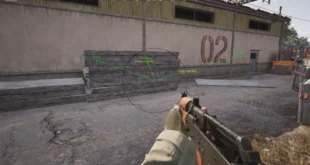How do you top the critically acclaimed launch of Crysis, a sci-fi shooter so genre-pushing, so technologically ahead of the curve, that it was awarded PC Gamer’s Game of the Year for 2007? For developer Crytek, the answer isn’t to churn out a quickie sequel – even though Crysis’ cliff-hanger ending surely demands one. Now.
No – first, Crytek has to deal with the “perception” problem. The perception that its CryEngine 2 tech won’t run on any rig less powerful than a Cray supercomputer. (It does.) The perception that Crysis was a financial flop. (Hardly – the game sold nearly 1.5 million copies worldwide, says EA.) And finally, following an interview in which Crytek president Cevat Yerli suggested that the company may not develop exclusively for the PC in the future, the perception that any new games in the Crysis series will be dumbed-down console ports.
To that last point, know this: Crysis Warhead is a PC exclusive. But, given that the Crysis series was supposed to be a trilogy, what it isn’t may surprise you.Read on for thestory of one of the Crysis saga’s most unlikely new heroes.
Here’s what Crysis Warhead isn’t: a sequel to the original Crysis. It isn’t an expansion pack, or even a stand-alone expansion. It isn’t the continuing story of Nomad, the original game’s faceless hero. Instead, Warhead is a full-sized game that fleshes out the side adventures of one of Nomad’s nanosuited teammates, in a story that runs parallel to the events of Crysis. (Think Barney’s wild ride in the Half-Life expansion Blue Shift.) Surprisingly, that teammate isn’t Prophet, the squad leader whose unseen adventures sparked the most questions (such as, where he got that high-tech alien weapon), but Sykes (aka, “Psycho”), the colorful former British SAS soldier who disappears toward the middle of Crysis, and then suddenly shows up on the aircraft carrier at the finale.
Psycho is meant to infuse the proceedings with “more character, more personality, more emotion,” says Cevat Yerli, Crytek’s cofounder and president. He’s a straight arrow who’s more direct and “a bit of a redneck,” Yerli adds.
In addition to having a unique face and voice, Psycho’s presence as a playable character means you’ll get to see him in third-person view during the game’s cut-scenes, performing tricks with the nanosuit that you may want to attempt yourself – a purposeful way of teaching you some creative ways to use your suit’s enhanced strength, speed, armor, and cloaking ability. But what about Prophet? Warhead won’t touch on his story, but Yerli hints that yet another not-quite-a-sequel may be on the horizon. Crytek’s Budapest studio is developing Warhead while its Kiev studio is working on an “unannounced project.”
Warhead’s plot is still under close wraps, except for a few facts: The game starts when Psycho leaves Nomad mid-Crysis to help out another unit and ends sometime before he shows back up on the aircraft carrier. You’ll again fight North Korean soldiers and aliens – anyone else remains a surprise. The game will contain two new vehicles, a hovercraft and the gun-mounted Advanced Scout Recon (ASR). New weapons will include dual submachine guns and a grenade launcher. Expect a single-player campaign of about 8to 10 hours, and a beefed-up multiplayer mode.
Fans of Crysis’ multiplayer will be overjoyed to learn that Warhead will include all its maps and content, including enhancements added post-launch. In addition to Crysis’ two multiplayer modes, Instant Action (deathmatch) and Power Struggle, Warhead will introduce a third that’s yet to be named. While Crytek won’t share details about it, the team says it won’t be as complex as Power Struggle, but will offer more team play than Instant Action. Though the nanosuit’s powers will again be muted in multiplayer – a necessity for fun, balanced gameplay, say the devs – Warhead’s new maps will feature more vertical environments and wide gaps to encourage the use of strength- and speed-augmented jumps. All the vehicles from both games’ single-player campaigns will also be available in multiplayer, including the Amphibious APC.
What’s really new in Warhead is Crytek’s determination to satisfy critics of the first Crysis. Some players were turned off by myriad issues, whether perceived or real. Chief among these was the game’s pushing of hardware boundaries, especially it’s so-called “future-proofing” meant to allow its visuals to scale upward with the release of future hardware. Yerli says this feature was included with the best of intentions, but the backlash was intense – gamers wanted to be able to max out Crysis’ graphics at launch on existing systems. In hindsight, Yerli agrees that the move was a “mistake,” and that it would’ve been wiser to unlock the game’s highest graphics settings in a patch when better hardware became available.
Crysis’ high system specs were another bone of contention, and Yerli acknowledges that the launch specs were high. (Patches have since better optimized the code.) Warhead, he promises, will reward those who upgraded to play Crysis. “If you were able to run Crysis, you’ll be able to run Warhead better,” says Yerli. That’s not to say that Warhead won’t push the graphics barrier. In addition to those easier-to-digest system requirements, Warhead’s graphics will benefit from a new global ambient lighting system that will boost visual acuity in the game’s environments and models. Improvements in the way lights and shadows interact with the world enhance small details previously unnoticed, and spotlight the game’s shader effects. And, though it hasn’t been added to the engine yet, Crytek plans to include new particle effects that are “dense and intense,” says Yerli.
None of these enhancements will impact framerates on current-gen machines, he notes. “We tried to push image quality and particle effects, but not at the cost of hardware performance.” And don’t worry about having Windows Vista and DX10 on your machine – you’ll be able to max out all settings in Warhead with your DX9-capable videocard. Crytek also listened to complaints that Crysis’ enemy AI was lacking, and is working to improve it for Warhead, especially in the aliens, who will appear to have more human-like organization. Group tactics will be improved, and Korean combat chatter will receive an upgrade to better inform you of what the North Korean soldiers are up to.
Warhead’s overall pace will also be polished. While Crysis started out with sandbox-like missions that allowed you to strategize how best to accomplish an objective, its missions turned tightly linear by the end. In Warhead, the scripted and sandbox aspects will be better integrated, and the plotting will remain consistent throughout the game. For example, vehicles will remain an important part of the action, but Warhead won’t include any missions where you have to pilot one (VTOL level, anyone?). Instead, you’ll be able to switch vehicles – or walk – at will.
Taking inspiration from Call of Duty 4, Yerli says that Warhead will be more consistently exciting, with fewer slow periods than Crysis. Like its lead character, the action will be more explosive and noisy, with plenty of scripted sequences setting up objectives. To punch up the dialogue, the script has also received a treatment from Susan O’Connor, writer of acclaimed shooters BioShock and Gears of War.
“I think we announced [Crysis] too early,” admits Yerli, who adds that unrealistically high expectations ultimately hurt the game. To that end, don’t expect a protracted development schedule – Warhead will ship this year. In fact, if Yerli has his way, all of Crytek’s future games will be announced a mere three months before their release date. But wouldn’t that be too late to create buzz? “If you have the right product, it’s never too late,” he counters.
To prove they’re not just blowing smoke up the ass of a visiting journalist, the Crytek team invites me to play some of the game’s alpha build. Even at this early stage, it seems shockingly feature-complete – although Crytek notes that the build I’m playing reuses assets from the original game that will eventually be replaced, and the new particle effects system has yet to be implemented.
I start out playing a quickie tutorial level called “Ambush” that, as in the first game, introduces you to movement, combat, and the use of your nanosuit’s abilities. But, unlike Crysis’ tutorial, you’re not alone – warfare surrounds you on all sides as the U.S. forces engage the North Koreans, who are battling over the rights to the mysterious alien spacecraft found off the coast of China. You see the icy after-effects of the aliens as you come across soldiers frozen mid-scream. Your commander barks out objectives such as investigating the source of an EMP pulse, as you maneuver through the battlefield, helping out troops along the way until you eventually hear a bit of information you can’t ignore.
In the second level, called “Cargo,” you discover that an old buddy, a jet pilot, has been shot down. Ignoring orders, you hightail it to the crash site to rescue him and grab his plane’s black box. Escorting him to the extraction site feels more like a co-op level than protection; your buddy is equally adept at combat. In fact, when we reached the site of VTOL extraction, I felt a little sad to see him go. While playing, I didn’t feel a strong urge to use my nanosuit’s special abilities, but Crytek plans to encourage their use in small ways, such as cut-scenes that show Psycho cloak to sneak up in front of an enemy, uncloak to startle him, and then punch him with super-strength. The team confirms that Psycho’s abilities will be the same as Nomad’s, but don’t deny that there could be a “surprise” later in the game.
Next, I try out a driving level in which I’m piloting an armored ASR through enemy territory as North Koreans give chase. But you don’t have to drive – as I quickly find out when I overturn my vehicle – and if you do, you’ll miss all the weapon caches hidden along the road and in enemy encampments. One of the secondary objectives is to find one such weapon cache, which contains a new weapon, the grenade launcher, an explosive piece of kit particularly effective against vehicles and groups of soldiers.
To give you as much choice as possible, tons of discarded vehicles litter the road. You can jump into another ASR, a jeep, a large truck, or anything else you find along the way, or you can creep along on foot, sniping enemies from behind trees and other cover. Finally, at a large North Korean checkpoint, I unleashed my full firepower – grenades, rifles, even a rocket launcher – at the base. And yes, there are just as many provocatively placed red explosive barrels as there were in the first Crysis. Maybe more.
 Lifeyet News Lifeyet News
Lifeyet News Lifeyet News





